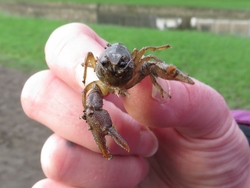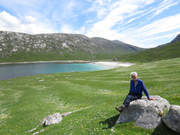 White-clawed crayfish stranded after the River Kent flooded. 6 December 2015
White-clawed crayfish stranded after the River Kent flooded. 6 December 2015 Looking down on the Lyth Valley that conclusion that for mice, field voles and small mammals would drown was inescapable. Winter Watch evidence helps interpret the floods of Cumbria and their impact on wildlife and ecology. They show a wildlife rescue hospital receiving unusual numbers of birds of prey for this time of year: owls, buzzards, kestrels, peregrines. The turbulent weather of the last two months exacerbates their feeding difficulty. With small mammals drowning they have difficulty finding food. Barn owls fly silently but to do this their feathers have less water-proofing oils. Their ability to hunt is reduced by 27% because of it.
Gradually, the impact of the floods becomes apparent. Only gradually. It will take a long time for the full extent of the damage to become clear. So too for the urban environment. The extent and scale of damage to bulldings continues to be revealed. As towns and cities grow the underlying hydrology is masked and hidden. At times of floods we are become rather more aware.
Remarkable swings in the weather, says weatherman Nick Miller. Unseasonal mildness and high temperatures account for the absence of winter migrants. Far fewer visiting birds. An absence I noticed and grieved over. Fieldfare, redwing and the occasional waxwing year are the glory of winter.

 RSS Feed
RSS Feed